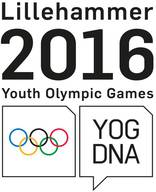The individual Skills Challenge for women and men were held for the very first time at Olympic Games during the 2012 Youth Olympic Winter Games. In this event, the best 15 female and 15 male athletes from the entered and qualified nations are allowed to compete, plus one male and one female athlete from the host country Norway. The participants will be selected from a global qualification program based on a series of individual skill tests designed by the IIHF.
The following Skills Challenge competitions will be held at the Youth Olympics and the qualification events: - Fastest Lap
- Shooting Accuracy
- Skating Agility
- Fastest Shot
- Passing Precision
- Puck Control
The Skills Challenge tests take place during the 2016 Youth Olympic Winter Games in Lillehammer, Norway, and at the domestic and international qualification events.
The national competitions will be held between 1st October 2014 and 7th May 2015 with the first-placed male and female athletes advancing to the Global Skills Challenge Summit to be held in July 2015 to select the male and female participants for the Youth Olympic Winter Games.
The events at the Youth Olympics will be made up of two phases: the Qualification and the Grand Final. All the skill tests will be conducted on a head-to-head, knockout basis, until a winner is declared and the participants will be seeded for each test. Players will earn points for their finishing position during each test.
The top-8 female and top-8 male players from the Qualification stage will progress to compete in the Grand Final.
During the Skills Challenge Grand Final players of each gender will compete for final individual rankings and medals.
|
The following female and male athletes qualified for the 2016 Youth Olympic Winter Games. The best 15 athletes in each category at the Global Skills Challenge Summit, 8-10 July 2015 in Vierumaki, Finland, as well as the athletes from host Norway will also participate in the Skills Challenge at the Youth Olympics in Lillehammer 2016. The seeding below represents the ranking from the Global Skills Challenge Summit.
Results from the Qualification: Men, Women
|
| | Men | | Women | 1. | | Erik Betzold (Germany) | | Millie Rose Sirum (Norway) | 2. | | Sebastian Cederle (Slovakia) | | Sena Takenaka (Japan) | 3. | | Sander Hurrod (Norway) | | Madison Poole (Australia) | 4. | | Benjamin Baumgartner (Austria) | | Tabea Botthof (Germany) | 5. | | Antonin Plagnat (France) | | Anita Muraro (Italy) | 6. | | Aleks Haatanen (Finland) | | Theresa Schafzahl (Austria) | 7. | | Natan Vertes (Hungary) | | SuYeon Eom (Korea) | 8. | | Carson Focht (Canada) | | Kiia Nousiainen (Finland) | 9. | | Andrei Pavlenko (Belarus) | | Chinouk van Calster (Belgium) | 10. | | Jake Riley (Australia) | | Martina Fedorova (Slovakia) | 11. | | Dino Mukovoz (Lithuania) | | Maree Dijkema (Netherlands) | 12. | | Ties van Soest (Netherlands) | | Daria Maximchik (Belarus) | 13. | | Mu-Hsin Hsieh (Chinese Taipei) | | Verity Lewis (Great Britain) | 14. | | Roy Kanda (Japan) | | Katarzyna Wybiral (Poland) | 15. | | Eduard Casaneanu (Romania) | | Diana-Alexandra Iuga (Romania) | 16. | | Oliver Curtis (New Zealand) | | Iara Haiek (Argentina)
|
The following six tests will be conducted. Find below descriptions and illustrations. For more sport-technical information download the 2016 Youth Olympic Games Skills Challenge Operations Manual and Test Protocol document here. (PDF, 1.4 MB)
|
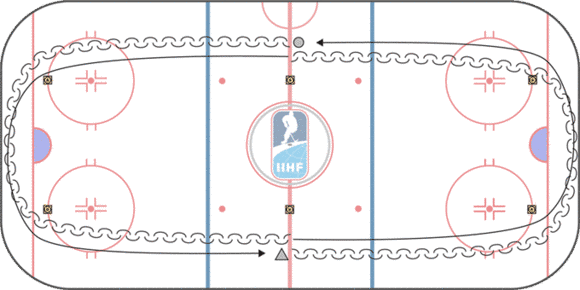
| - Cubes are placed over the Skill Test 1 dots on the ice
- A set of Light Sensors are set up at the both start/finish lines
- All players sit on the benches
- Players will start from the start/finish line on both sides of the rink
- Players must start behind the start/finish line
- This test is timed
- The first pair of players will be called to the start line
- The two (2) players will skate at the same time
- The test begins on the whistle
- The players will begin skating backwards in a counter-clockwise direction
- When the player has completed half a lap they will pivot from backwards to forwards
- The pivot must be performed inside the transition zone (after the centre red line and before the far blue line)
- The time will stop once any part of the player’s body (not including stick) crosses the start/finish line from which they started
|
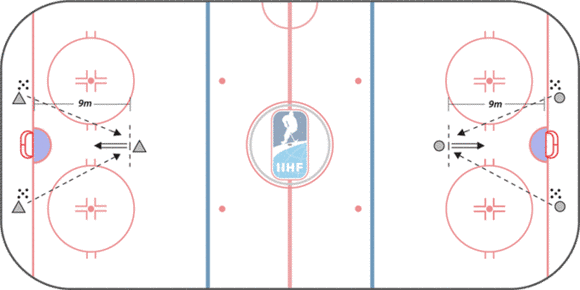
| - Use spray paint to draw a line connecting the 3, Skill Test 2/4, dots on the ice
- Cubes are placed on the ends of the line to form the shooting line
- One set of 4 breakable targets are placed into each the net , 1 target per corner
- The shooter is positioned behind the shooting line
- Two (2) passers (coaches) are positioned behind the goal line 5 metres to either side of the net with pucks
- This test is timed with a limit of 30 seconds
- The first pair of players will be called to the shooting line
- Two (2) players will shoot at the same time
- The test begins on the whistle
- The passers will pass the pucks alternatively to the shooter
- The shooter receives the passes one at a time and shoots at the targets
- The shooter that hits all four targets in the shortest time is the winner
|
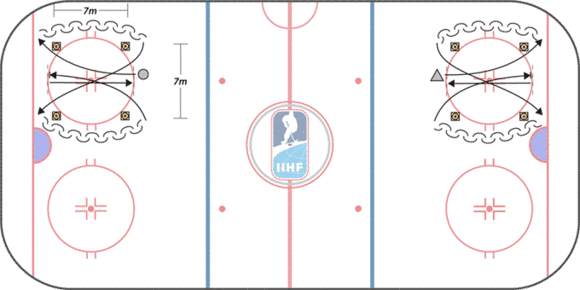
| - Cubes are placed over the Skill Test 3, dots on the ice
- Paint the start/finish line between the two dots across the top of the faceoff circle
- Players will start from behind the start/finish line
- This test is timed
- The test begins on the horn
- The player skates forward towards cube 1
- At cube 1 pivots forward to backward
- Skates backwards along the outside to cube 2
- Player pivots at cube 2 from backward to forward
- The player skates diagonally towards cube 3 and pivots from forward to backward
- Skates backwards along the outside to cube 4
- At cube 4 the player pivots backward to forward and skates forward to goal line
- Stops and skates forward to the start/finish line Start/Finish Line
|
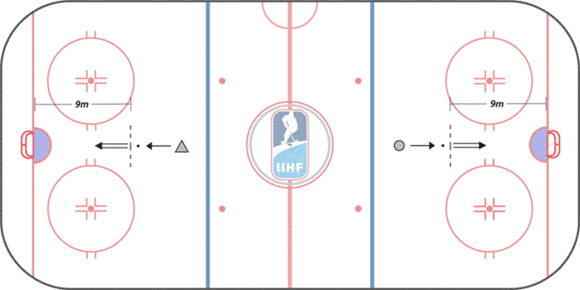
| - Use spray paint to draw a line connecting the 3, Skill Test 2/4, dots on the ice
- Cubes are placed on the ends of the line to form the shooting line
- The radar/speed gun is placed to measure the speed of all the players’ shots
- The exact placement radar/speed gun is undetermined at the moment
- Group of pucks located on the Blue Line
- One puck is placed behind the shooting line
- Two players compete head to head at each end of the ice
- One player at a time shoots the stationary puck from the shooting line
- Each player attempts 2 shots
- The player can skate towards the puck before shooting
- They must skate from inside the near blue line
- All shots must hit the net to count
- Both shots are registered by radar in kilometres per hour
- The fastest registered shot of two (2) attempts will be counted
- The player with the fastest recorded shot wins
|
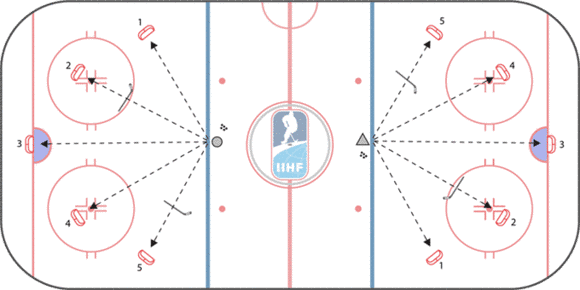
| - 5 targets, are placed over the, Skill Test 5, dots on the ice
- An obstacle (hockey stick) is placed on the ice, over the test 5 dots, between the passer targets 2 and 5
- Pucks are behind the blue line in the centre of the ice
- The blue line marks the passing line
- This test is a limited timed test of 30 seconds and starts on the horn
- The passer stands behind the passing line
- The passer has to hit each of the targets in order 1 to 5
- The passer must successfully hit a target before moving to the next
- At target 2 and 5 the passes must go over the obstacle (hockey stick)
- The test continues until one players hits all 5 targets
- The passer that hits all 5 targets in the shortest time is the winner
- If time limit is passed the number of targets and passes will count
|
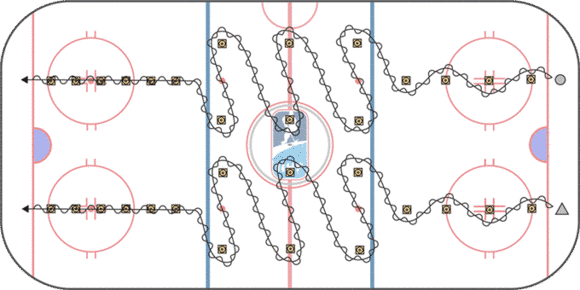
| - Cubes (32) are placed over the, Skills Test 6 dots, on the ice
- The goal line at one end of the ice marks the start line
- The goal line at the opposite end of the ice is the finish line
- Players will start the start line
- This test is timed
- Both players begin with their feet behind the start line
- The test begins on the horn
- The player skates straight forward with the puck towards the line of 4 cubes
- The player skates through the 4 cubes in a slalom pattern
- In the Neutral Zone the player goes to the one cube of the first pair
- The player weaves through the 3 pairs of cubes
- After the last pair of pylons, the player skates forward to the 5 stickhandling obstacles
- While straddling the stickhandling obstacles the player stickhandles the puck through all 5
- The players then skate across the finish line to complete the test
|
|


